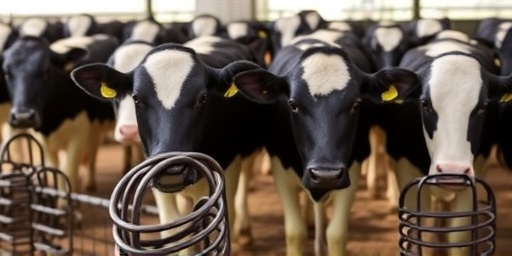In a concerning escalation of the ongoing bird flu outbreak, the Centers for Disease Control and Prevention (CDC) has confirmed the first human infection with highly pathogenic H5N1 avian influenza in the United States. The patient, a dairy worker in California, became exposed to infected cows on a local dairy farm, marking a significant shift as this strain has primarily affected poultry and livestock until now. Health officials emphasize there is no evidence of human-to-human transmission, but the case has triggered intensified surveillance across the nation’s agricultural sectors.
- California Dairy Worker Contracts H5N1 from Infected Cows
- CDC Genetic Sequencing Links Human Case to Livestock Strain
- No Human-to-Human H5N1 Transmission Detected Amid Monitoring Surge
- U.S. Bird Flu Outbreaks Explode in Poultry and Cattle Herds
- Health Agencies Ramp Up H5N1 Prevention and Pandemic Preparedness
California Dairy Worker Contracts H5N1 from Infected Cows
The infected dairy worker, whose identity remains confidential to protect privacy, works at a dairy farm in California’s Central Valley, a region renowned for its vast milk production. According to the CDC’s announcement on Wednesday, the worker developed mild symptoms including eye redness and discomfort after direct contact with sick cows exhibiting signs of illness such as reduced milk production and respiratory distress. Samples from the worker’s nasal passages tested positive for H5N1, the same clade 2.3.4.4b strain circulating in U.S. cattle and poultry since early 2024.
This incident represents a pivotal moment in the H5N1 bird flu saga, as it’s the first documented human case linked to dairy cattle rather than wild birds or poultry. California’s dairy industry, which produces over 20% of the nation’s milk, has reported multiple herd infections in recent months. State veterinarians identified the farm’s cows as positive for H5N1 through routine testing mandated under federal guidelines. “The worker’s exposure likely occurred during milking or close handling of symptomatic animals,” stated Dr. Karen Fong, a CDC epidemiologist involved in the investigation.
Local health departments in California, including the California Department of Public Health (CDPH), acted swiftly by isolating the worker and conducting contact tracing among farm employees and family members. Preliminary tests on 10 close contacts have all come back negative, providing early reassurance. The dairy worker received antiviral treatment with oseltamivir (Tamiflu) and is recovering at home, with symptoms resolving within days—a pattern consistent with prior mild H5N1 cases worldwide.
CDC Genetic Sequencing Links Human Case to Livestock Strain
Laboratory analysis by the CDC’s influenza division revealed that the virus from the California dairy worker is genetically nearly identical to H5N1 samples from infected cows on the same farm and nearby herds. This D1.1 genotype, part of the Eurasian H5 clade, has been responsible for devastating poultry outbreaks across 48 U.S. states, culling over 100 million birds since 2022. In cattle, infections have now hit 11 states, with California confirming cases in four counties as of this week.
“The genomic data shows no mutations suggesting enhanced human transmissibility,” reassured CDC Director Dr. Mandy Cohen in a press briefing. This is crucial, as H5N1 has a historical human case fatality rate exceeding 50% in over 900 global infections since 2003, mostly from poultry exposure in Asia and Africa. However, U.S. cases remain rare and mild, with four prior detections in farm workers since 2024—all linked to poultry culling and resolving without hospitalization.
Experts attribute the virus’s jump to mammals, including cows, to its adaptation via reassortment with seasonal flu strains. A study published in Nature last month highlighted how H5N1 in dairy cows sheds high viral loads in milk, posing risks during unpasteurized handling. Federal agencies like the USDA and FDA have issued warnings against consuming raw milk, with pasteurization confirmed to inactivate the virus.
- Key Genetic Findings: 99.9% match between human and bovine samples.
- Mutation Risk: No PB2 E627K marker for mammalian adaptation detected.
- Surveillance Boost: CDC expanding One Health genomic sequencing to 50 state labs.
No Human-to-Human H5N1 Transmission Detected Amid Monitoring Surge
Public health leaders are unequivocal: this California dairy worker case shows no signs of human-to-human spread, a threshold that would elevate the threat to pandemic levels. The CDC’s contact tracing, involving over 50 individuals including coworkers and household members, has yielded zero secondary infections after 10 days of follow-up—the standard incubation window for H5N1.
“We’ve seen mild cases like this before, and they’ve never sparked chains of transmission,” said Dr. Tom Frieden, former CDC director and current Resolve to Save Lives president. This aligns with global patterns; of 13 U.S. H5N1 detections in humans since 2022, all were isolated. The World Health Organization (WHO) classifies the current risk to the general public as low, though high for those in close contact with infected animals.
In response, the CDC is distributing 10,000 more doses of H5N1 vaccine candidates from stockpiles, originally developed for poultry workers. California’s governor has allocated $20 million for farm biosecurity upgrades, including PPE distribution and ventilation improvements. Nationally, the USDA reports 1,200 dairy herds under quarantine, with voluntary testing encouraged to curb silent spread.
U.S. Bird Flu Outbreaks Explode in Poultry and Cattle Herds
The backdrop to this human case is an unprecedented H5N1 rampage through American agriculture. Since January 2024, bird flu has infected cattle in 14 states, up from zero pre-2024, with wastewater surveillance detecting viral fragments in 20% of dairy-heavy regions. Poultry losses exceed 110 million birds, costing $4 billion and driving egg prices to record highs—up 70% year-over-year.
In California alone, 15 dairy herds and 200,000 poultry have been depopulated. “This is the largest animal influenza outbreak in U.S. history,” noted USDA Chief Veterinary Officer Dr. Rosemary Sifford. Spillover risks rise with inter-farm animal movements; a single infected cow can shed virus for weeks, contaminating milking equipment.
- Poultry Impact: 48 states affected; backyard flocks hit hardest.
- Cattle Surge: Mild symptoms like fever in herds; milk discard mandates in place.
- Wildlife Role: Migratory birds seeding farms via droppings.
Economists warn of sustained supply chain pressures, with cheese and butter prices projected to rise 15% through 2025. International trade halts on U.S. poultry exports to 50 countries add economic sting.
Health Agencies Ramp Up H5N1 Prevention and Pandemic Preparedness
Looking ahead, federal and state officials are fortifying defenses against further H5N1 evolution. The CDC plans to integrate bird flu testing into routine flu surveillance at 500 sentinel sites, while the FDA accelerates bulk milk testing protocols. A new $1 billion USDA investment targets rapid diagnostics deployable on farms within hours.
Vaccine frontrunners from Moderna and GSK, leveraging mRNA tech, show 90% efficacy in ferret trials against the cattle strain. Human trials could begin by mid-2025 if cases multiply. “We’re preparing as if this could change—we monitor mutations weekly,” said NIH Director Dr. Monica Bertagnolli.
Public guidance remains straightforward: avoid raw milk, cook poultry thoroughly, report sick birds or livestock promptly, and use PPE on farms. Community education campaigns in California dairy communities, reaching 50,000 workers, emphasize hygiene. Globally, WHO urges 100+ countries to align surveillance, as H5N1 cases rise in Europe and Asia.
As outbreaks persist, experts predict more human spillover events unless animal reservoirs are controlled. The California dairy worker’s case serves as a clarion call: vigilance now prevents catastrophe later. With coordinated One Health efforts—merging human, animal, and environmental monitoring—the U.S. aims to contain H5N1 before it adapts further.









